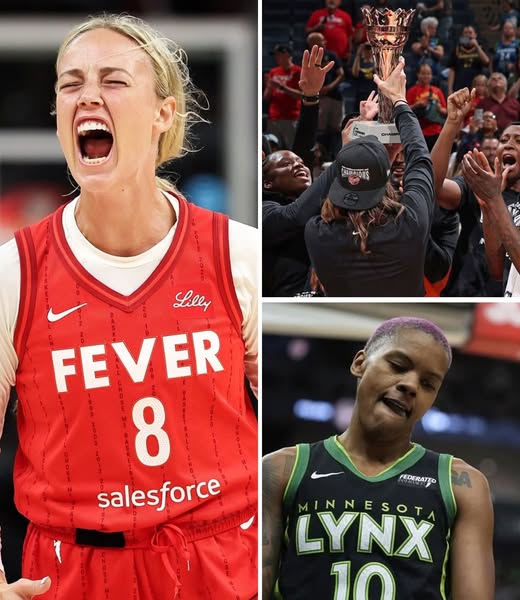The WWE-like energy in Minneapolis’s Target Center was electric Tuesday night, lit up by a spectacle that will surely echo through the WNBA history books. On July 1, 2025, the underdog Indiana Fever—missing their mercurial star Caitlin Clark—showed no mercy. With Sophie Cunningham fueling the inferno off the bench and Natasha Howard orchestrating a defensive masterclass, they obliterated the Minnesota Lynx in a jaw-dropping 74‑59 Commissioner’s Cup Finals performance.
From the opening tip, the Lynx took charge, bullying their way to a 20‑12 first‑quarter lead, exploiting mismatches and controlling the glass. But as the second quarter began, Indiana found a different gear. A blistering 18‑0 run to close the half flipped the script entirely, turning what looked like a rout into the Fever’s stage. Minnesota collapsed, unable to score for the final 8:13 of the half, thanks to a stifling defensive effort led by Howard, whose presence inside forced contested shots at every turn .
Sophie Cunningham, playing her trademark enforcer role off the bench, emerged as the catalyst behind that run. With precision shooting, she dropped three 3‑pointers in a tightly wound sequence—two early in the second and one late in the fourth—each clanging home like a final nail in the Lynx coffin . By night’s end, Cunningham had tallied 13 points and seven rebounds in just over 25 minutes, embodying the aggressiveness and intensity that earned her top billing on social media post‑game .
While Cunningham’s sharpshooting electrified the crowd, it was Howard who anchored the performance. The former Defensive Player of the Year delivered a polished blend of physicality and finesse: 16 points, 12 boards, 4 assists, and flawless free‑throw shooting—a perfect 8 for 8 from the line—culation that earned her Finals MVP honors . But numbers alone don’t tell the full story. Howard locked down Napheesa Collier, Minnesota’s scoring dynamo, limiting her to a cold 12 points on 6-of-18 shooting—all while Minnesota mustered one of the worst offensive performances of the season, shooting just 34.9% from the field .
The game’s chart tells the tale:
Minneapolis skidded to a halt after the first quarter, scoring just 7 in the second and allowing the Fever to surge ahead. Although they recovered modestly in the third and fourth, Indiana’s dominance ensured the Lynx never breathed easy again .
Indiana’s supporting cast surged with purpose. Aliyah Boston delivered 12 points, 11 rebounds and 6 assists, staking her claim as more than just a young prospect Guards Aari McDonald and Kelsey Mitchell delivered 12 points apiece, threading smart drives and picking defenses apart. Coach Stephanie White was quick to praise their cohesion. “They’re tough, mentally and physically… learning to make big plays… is important” .
On the flip side, Minnesota couldn’t buy a bucket. Their usual barrage of perimeter firepower was silenced: just 4‑for‑16 from deep . Collier, the league’s top scorer (.24.4 ppg), was neutered in the middle, while Alanna Smith’s 15 points were a rare bright spot
As the final buzzer rang, the $500,000 prize pool — split evenly among the 11 players — was not just a financial windfall but a statement: this Fever roster is built for moments. Though Caitlin Clark sat sidelined with a groin injury, the team gutted out a performance rich in grit and unity . The victory also carried charitable significance: Indiana’s nonprofit partner, the Peace Learning Center in Indianapolis, received a $23,000 donation, spotlighting the sport’s capacity for community impact .
Speaking of Clark, though sidelined, she wasn’t silent. Social media exploded when she criticized WNBA management for awarding more prize money for this Cup than for winning the league championship—$50,000 per player vs. around $20,000 for June’s league title . Her live‑streamed rants—“makes no sense… help us out Cathy”—added fuel to leaguewide discussions on compensation, putting league leadership on the back foot .
Beyond the tangible numbers, what this win symbolized might matter even more. ESPN’s pre-game preview confidently projected a Lynx blowout; the network even produced a “Lynx dominate Fever” graphic prematurely, only to scramble post-game to correct their blunder (. The visual, meant as vindication of Minnesota’s home‑court superiority, instead became an emblem of overconfidence shattered by Indiana’s tangible execution.
At the heart of this collapse was Indiana’s defense—a full‑court press on accountability. Minnesota’s halftime funk—an 18‑0 run capped by Cunningham’s triple—became a microcosm for the entire game: once the Fever settled in, the Lynx couldn’t find their footing .
“Confidence,” said Coach White, “comes from moments like this… learning to pull for one another” . Indeed, this felt like a launching pad, not just a trophy—proof that Indiana can thrive even without its marquee player. The real test: can they keep this momentum when Clark returns? White cautioned against expecting her back too soon, saying “making progress and feeling good are different things”
Minnesota, meanwhile, must regroup. A longreigning powerhouse in the in-season Cup, they now face the bitter taste of being humbled on home soil. Coach Cheryl Reeve lamented the lack of fight and discipline, and insisted they’ll use this as fuel—but player accountability looks more urgent than ever .
What of the MVPs? Howard, who shined as both the enforcer and the glue, already has a decorated legacy. A former Defensive Player of the Year, a WNBA champion with Seattle, now she adds Commissioner’s Cup MVP to her resume—and was instrumental in shutting down Collier’s offensive rhythm . And Cunningham once again validated the “enforcer” hype, hot from deep and steroids of momentum, with her 3‑point bombs leaving Lynx defenders reeling.
Despite her absence on the floor, Caitlin Clark owns the narrative. A social media climactic moment saw her celebrating, dancing on Instagram Live, then punctuating with a call‑out that resonated: “Everybody in the league is sick.” That fiery defiance—woven through both celebration and critique—only deepens the team’s swagger as villains to the wider WNBA .
Now, Indiana enters the All‑Star stretch at .500: 8‑8 with seven games to play before the break. And unlike past seasons where they limped into June, this year comes with a swagger forged in adversity and disbelief. Imagine the narrative if Clark returns fully healthy, riding Wolfe‑like momentum into the playoffs alongside the Cup champions.
Minnesota still looks to contend—in both conference and Cup contexts. But they’ve been served a wake‑up call: home‑court advantage means little if your mental preparation doesn’t match the moment. Rebounding, turnovers, mental toughness—it’s all on the table now.
And the Cup itself? Once a curious in‑season side dish, this final placed it front and center. The Fever’s trophy lift lit the way for a sharper conversation about competitive integrity, player compensation, and why the WNBA matters beyond its postseason. With $500,000 on the line, social media chanting “Sophie for the culture” and “Clark is right,” this felt like the Cup became the message as much as the milestone .
In the end, it was offensive execution married to defensive intensity—a blueprint that started in Minneapolis and will follow them back to Indiana. It wasn’t just a win; it was a warning. Sophie Cunningham and Natasha Howard left no mercy—and their ounce‑by‑ounce destruction of the Lynx is the spark that could ignite an entirely new storm in red and navy.
The Fever aren’t just Cup champions—they’re contenders. And anyone expecting a return to “peaking only in May” better adjust their expectations. This performance had teeth. It had spine. Mostly, it had purpose.
Now, with torch lit and message sent—“we’re here”—the real journey begins.



